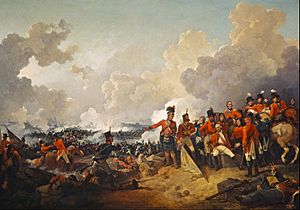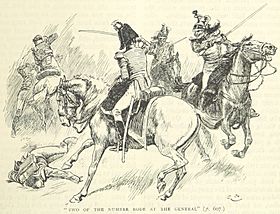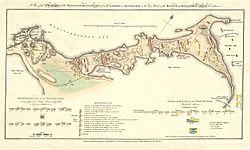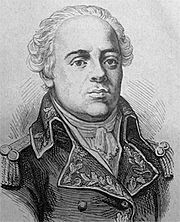Battle of Alexandria (1801) facts for kids
Quick facts for kids Battle of Alexandria |
|||||||
|---|---|---|---|---|---|---|---|
| Part of the French Campaign in Egypt and Syria during the War of the Second Coalition | |||||||
 The Battle of Alexandria, 21 March 1801, Philip James de Loutherbourg |
|||||||
|
|||||||
| Belligerents | |||||||
| Commanders and leaders | |||||||
| Strength | |||||||
| 12,000 14,200 |
10,000 14,000 16,000 |
||||||
| Casualties and losses | |||||||
| 1,500 | 1,700 3,500 4,000 5,000 |
||||||
The Battle of Alexandria, also known as the Battle of Canope, was a big fight on March 21, 1801. It happened between the French army, led by General Jacques-François Menou, and the British army, led by Sir Ralph Abercromby. This battle was part of Napoleon's French campaign in Egypt and Syria, which started in 1798.
The fight took place near ancient ruins in Egypt. It was on a narrow strip of land between the sea and Lake Abukir. The British soldiers had been moving towards Alexandria after earlier battles on March 8 and March 13.
Getting Ready for Battle
After an earlier defeat, General Menou arrived from Cairo to take charge of the French forces. He decided to attack the British on March 21. The French planned to attack in different sections. General François Lanusse would lead the left side. General Antoine-Guillaume Rampon would be in the middle. General Jean Reynier would lead the right side.
On the night of March 20, the British army was ready. Their right side was near the sea and some old ruins. Their left side was by Lake Abukir and a canal. The British soldiers faced southwest, towards the city of Alexandria. They had different groups of soldiers in position, including a reserve division and the Foot guards.
The Battle Begins
General Abercromby expected an attack during the night. So, on March 21, the British soldiers slept in their battle positions. At 3:30 in the morning, the French attacked. They quickly pushed back the British guards.
The French, led by Lanusse, bravely charged forward from their left side. They attacked along the seashore and towards the British defenses. The main attack hit the British soldiers led by Major-General Sir John Moore. The 28th (North Gloucestershire) Regiment of Foot faced the strongest part of this attack.
The British fought back hard and stopped this first French charge. During this intense fighting, both French Generals Silly and Lanusse were hurt. General Lanusse was hit in the leg by a cannonball. He tried to keep fighting but was hit again and sadly died.
Soon, the French in the middle, led by Rampon, joined the fight. Even in the dark, they managed to get between the British lines. A confused and fierce fight happened among the ruins. Many French soldiers were killed or captured. The British 42nd Regiment of Foot even captured a French flag. Other British regiments, like the 23rd Regiment of Foot and 40th (the 2nd Somersetshire) Regiment of Foot, also fought bravely.
During this time, General Menou, the French commander, seemed to be watching more than leading. But then, he ordered his cavalry (soldiers on horseback) to charge forward. The cavalry commander, Cézar Antoine Roize, tried to argue against it, but the charge went ahead. The French cavalry rode all the way to the British camp. They caused many losses for the 42nd Foot. But the British had dug trenches and used their guns, which stopped the cavalry.
General Roize told his men, "Friends, they are sending us to glory and death!" The charge was very strong. The brave General Roize led his men deep into the British camp. The British soldiers were scared and tried to hide. But the British had dug hidden pits and spread sharp objects on the ground. The French horses fell into these traps. General Roize, seeing no escape, fought on foot like a lion. He was killed, along with many of his men.
The 28th (North Gloucestershire) Regiment of Foot faced attacks from both the front and back. Their commander gave a famous order: "Front rank stay as you are, rear rank about turn." This meant half the soldiers faced one way and half faced the other. Because of this, the regiment later added a special badge to the back of their hats.
During the cavalry attack, Sir Ralph Abercromby was briefly captured by French dragoons (cavalry soldiers). But a brave Scottish soldier from the 42nd Regiment quickly rescued him. Around this time, Abercromby was shot in the leg. This wound would later be fatal. But he stayed on the battlefield and kept leading his troops until the end.
The French infantry attacked the center again, but the British Guards stopped them. The British left side also held its ground easily. However, the French cavalry again got very close to the British reserve forces.
Around 8:30 in the morning, the fighting started to slow down. The last shots were fired at 10:00 a.m. Most of the French attacks had focused on the British right side. Historians say that the British infantry (foot soldiers) had a powerful way of firing their guns together. This "volley" fire helped them win the day, even more than their individual bravery. The British gunboats near the shore also helped by firing cannons at the French.
What Happened Next
Both armies had about 14,000 soldiers fighting in this battle. The British lost 10 officers and 233 men killed. Another 60 officers and 1,193 men were wounded. Three officers and 29 men were missing. General Abercromby died from his wound on March 28.
The French lost about 1,000 soldiers killed, 600 wounded, and 200 taken prisoner. Some historians think their total losses were much higher, up to 4,000. Three French generals were killed: Lanusse, Roize, and Baudot. Several other senior officers were also wounded. The French also lost a flag and one cannon.
After Abercromby's death, John Hely-Hutchinson took command of the British forces. They then moved on to surround Alexandria. The French soldiers defending Alexandria surrendered on September 2, 1801.
Later, General Reynier wrote about the battle and strongly criticized General Menou. Napoleon ordered these writings to be kept secret. In their defense, Menou and other French generals blamed Reynier and others for the defeat.
See also




